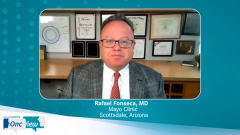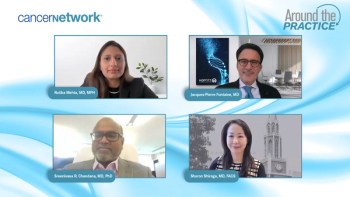
Utilizing Daratumumab in the Frontline Setting Versus in Later Lines in MM
Daratumumab effectiveness is evaluated as a frontline treatment approach versus in later lines of therapy in patients with multiple myeloma.
Episodes in this series

Rafael Fonseca, MD: At the last American Society of Hematology [ASH] meaning we presented a simulation that asked the following question is it better to use some of your best drugs up front or save them for later? And very specifically we asked the question, if you look at patients who have transplant-ineligible myeloma, would it be better to start with something like the MAIA regimen? So, utilize Dara-Rd and then provide patients with rescue with either Pomalidomide or Carfilzomib, or would you be better off starting with something like RVd and then doing a rescue strategy with a Daratumumab-based combination?
Well, our study focused on Daratumumab. It's truly drug agnostic and the real question is are you better off using your best drugs upfront? And we did the study using the real-world data sets which can inform this type of questions. So that's an important one because we looked at populations that would be similar to what you would start up front as well as what you would use in the setting of relapse and refractory, and we can look at the duration of therapy that patients get. Importantly, we also introduce an intermediate step between the first line and the second line that includes the attrition rates.
We and others have published that there's a significant rate of attrition between the various lines of therapy. Now this is a critical point because what we have seen is if you look at the transplant ineligible, there's about a loss of about 50% of patients per each one of the lines of therapy. That is for a number of reasons, sometimes successful long-term treatment but also disease progression, patient preference, and unfortunately disease-associated death. And when we introduce those two factors and we use the real-world analysis, we projected in the simulation that it would be preferable for patients to start on a Daratumumab-based combination. In this case the DARA-Rd followed by rescue at the first line with Pomalidomide and Carfilzomib versus using RVd and then a rescue with a Daratumumab-based combination. Again, I think this is agnostic treatment. It just speaks that you have to use your best treatments up front so that patients can derive that benefit.
We projected in the study which is a simulation again that we would have a median overall survival of about 9.1 years with a preferred strategy that would be about 2.5 years longer. Overall survival that's starting with RVd and then trying to do a rescue with the Daratumumab. And 3.5 years longer than starting with a doublet Rd and then doing a rescue with Daratumumab. I always say don't save your power drive, don't save the best for later because there might not be that later.
There's obviously the need to have this be tested in a prospective randomized phase-III clinical trial. That trial has been conducted. It has some slight difference in the design but it's still going to be several years out, before we know the results of that trial. Given that the two options are supported by the guidelines, category one, we think this is perhaps one more reason to consider, a MAIA frontline, the key frontline option and more so also in the absence of peripheral neuropathy for this patient. So, we're excited by how real-world data can actually inform in a situation like this, what might be the best choice for the frontline therapy of our patients.
Thank you for watching the Contemporary Cancer Network OncView Program from MJH Life Sciences. We hope you found this to be valuable to your clinical practice and we'll see you at the next one.
Transcript edited for clarity.
Newsletter
Stay up to date on recent advances in the multidisciplinary approach to cancer.
















































































